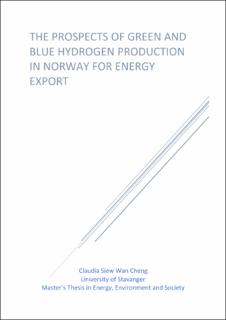| dc.contributor.advisor | Langhelle, Oluf | |
| dc.contributor.author | Cheng, Claudia Siew Wan | |
| dc.coverage.spatial | Norway | en_US |
| dc.date.accessioned | 2021-07-06T08:48:33Z | |
| dc.date.available | 2021-07-06T08:48:33Z | |
| dc.date.issued | 2020-01-15 | |
| dc.identifier.uri | https://hdl.handle.net/11250/2763507 | |
| dc.description | Master's thesis in Energy, Environment and Society | en_US |
| dc.description.abstract | As the threat of climate change impacts looms, with global temperatures rising to 1.5oC as early as 2030, the need for rapid low-carbon energy transition is more urgent than ever. As a global leader in climate change negotiations, the EU has committed to become carbon neutral by 2050 and hydrogen is set to play a critical role in decarbonising sectors which are difficult to electrify such as freight transport, energy-intensive industries required high-grade heat and power generation sectors. This offers an opportunity for Norway to mitigate the risk of declining demand and supply of its fossil-fuel based energy exports. This thesis provides an overview of the key drivers and barriers that could affect the prospects of blue and green hydrogen export in Norway. Given that transitions, in general, do not follow a linear-process, the thesis uses exploratory scenarios as a framework to enhance the understanding of how the interplay of these drivers could affect the trajectories of the pathways of blue and green hydrogen developments in Norway. The findings and analysis show that Norway is well-positioned in terms of natural resources availability, existing compatible infrastructure and technological expertise for the development of both types of hydrogen and has a great potential for becoming a market leader in the export of hydrogen. As its natural gas reserves deplete, the role of green hydrogen in a low-carbon energy system is likely grow more significantly. Therefore, it is critical for policymakers to consider the eventual phase-out of blue hydrogen and scaling up of green hydrogen in its strategy as early as possible. Overall, blue hydrogen should be viewed as a short-term solution to enable a rapid hydrogen transition, but green hydrogen would offer better prospects for a more sustainable economy for Norway. | en_US |
| dc.language.iso | eng | en_US |
| dc.publisher | University of Stavanger, Norway | en_US |
| dc.relation.ispartofseries | Masteroppgave/UIS-SV-IMS/2020; | |
| dc.rights | Navngivelse 4.0 Internasjonal | * |
| dc.rights.uri | http://creativecommons.org/licenses/by/4.0/deed.no | * |
| dc.subject | Norway | en_US |
| dc.subject | MLP | en_US |
| dc.subject | scenario analysis | en_US |
| dc.subject | socio-technical transitions | en_US |
| dc.subject | climate change | en_US |
| dc.subject | hydrogen | en_US |
| dc.subject | fuel cell | en_US |
| dc.subject | energy transition | en_US |
| dc.subject | energy export | en_US |
| dc.subject | multi-level perspectives | en_US |
| dc.subject | klimaendringer | en_US |
| dc.subject | energieksport | en_US |
| dc.subject | Norge | en_US |
| dc.title | The prospects of blue and green hydrogen in Norway for energy export | en_US |
| dc.type | Master thesis | en_US |
| dc.description.version | submittedVersion | en_US |
| dc.subject.nsi | VDP::Samfunnsvitenskap: 200 | en_US |
| dc.source.pagenumber | 95 | en_US |

